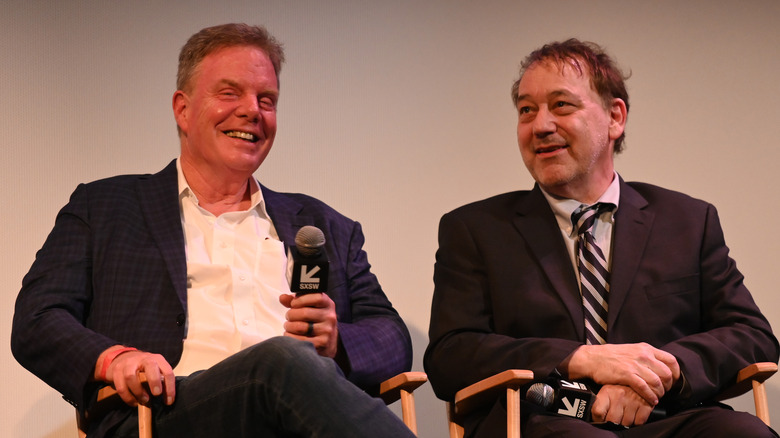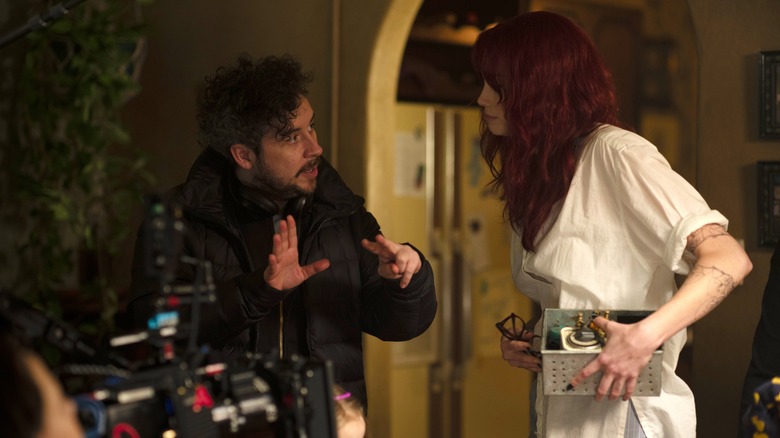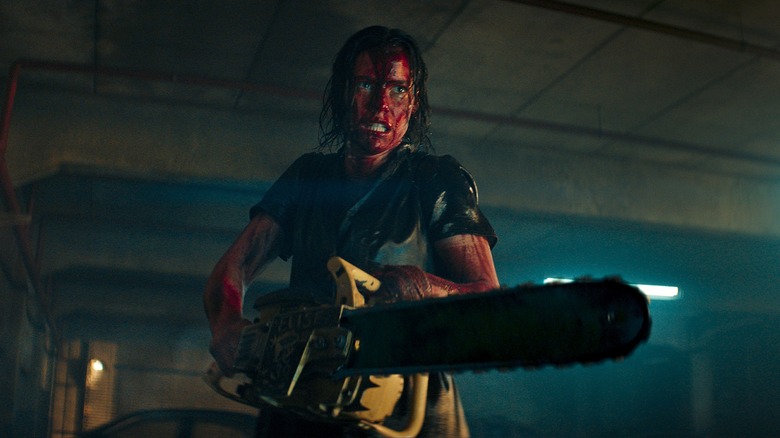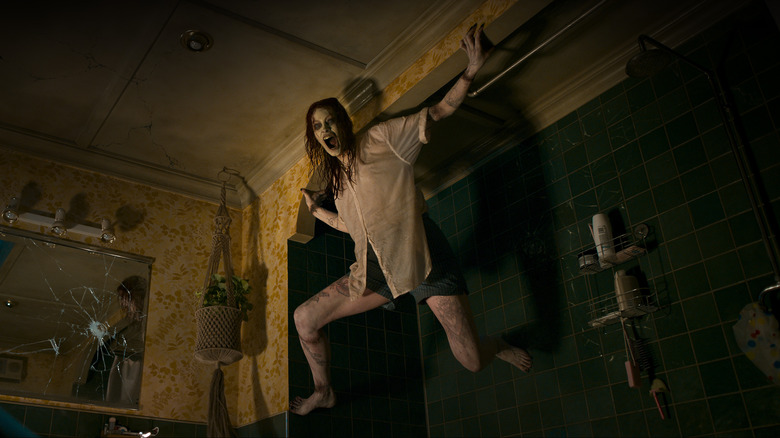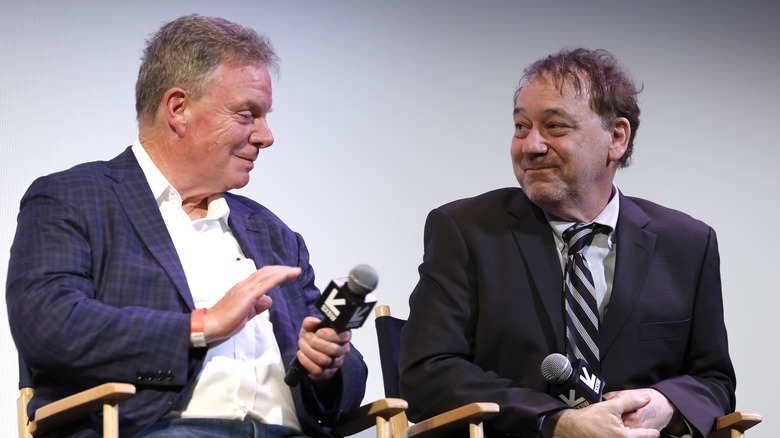Producers Sam Raimi And Rob Tapert On Director Lee Cronin's Bloody New Vision For Evil Dead Rise - Exclusive Interview
Together with actor Bruce Campbell, director Sam Raimi and producer Rob Tapert introduced the cinematic world to a new brand of horror with 1981's "The Evil Dead," a labor of love from the Michigan natives that quickly attained cult movie status. Now, 42 years after the debut of the modern horror classic, Raimi, Tapert, and Campbell are continuing the saga as producers on writer-director Lee Cronin's "Evil Dead Rise." But like the 2013 remake of "The Evil Dead," the horror-comedy sensibilities of the trio's two "Evil Dead" sequels and "Ash vs Evil Dead" TV series have been stripped out of the franchise in favor of straight-up horror.
Opening in theaters Friday, April 21, "Evil Dead Rise" begins in a familiar wooded setting as a horrifying turn of events unfolds. The film then revisits what transpired the day before, where Ellie (Alyssa Sutherland), a single mother of three children, becomes demonically possessed after her teen son, Danny (Morgan Davies), unearths a Necronomicon — aka "The Book of the Dead" — from the formerly sealed-off space beneath their broken-down suburban high rise. Once Danny and Ellie's estranged sister, Beth (Lily Sullivan), play a recording found with the evil book, an invisible demonic force is unleashed and threatens not only Ellie's family but also other tenants in the building.
In an exclusive interview with Looper, Raimi and Tapert delved into Cronin's new vision for the "Evil Dead" franchise, revealed the reason they pulled back on the amount of Easter eggs for original "Evil Dead" trilogy fans to find in the film, revisited the use of practical effects that helped those original films attain their classic statuses, and more.
Tapert and Raimi knew Cronin nailed the Evil Dead tone in the script process
I love how the film opens with the point-of-view shot going through the woods. From the very first frame, I could tell that "Evil Dead Rise" nailed the tone of the previous "Evil Dead" movies. It felt like it fit. Of course, I'm looking at the completed product, so at what point during filming were you two able to sit back and say, "This really does feel like it belongs in the 'Evil Dead' universe"?
Rob Tapert: We knew based on Lee in our conversations — he said everything right going into filming so that we didn't have huge concerns. There were minor fixes along the way. The beauty for Sam and I and the "Evil Dead" franchise is that the director has a tremendous amount of creative freedom, and our goal, our job, is to help them exercise that creative freedom and bring it to the forefront and still go, "Well, that doesn't sit in our universe perfectly" or "We should augment this in order to make it work." But once Lee was aboard and we saw a script, we knew we were making an "Evil Dead" movie.
Sam Raimi: Yes, Lee's understanding of "The Evil Dead" was apparent from the script state. He told us that he was a big fan of the series and understood the moments and the characters of "The Evil Dead" and how they worked. They're an ancient demonic force that is resurrected through incantations to The Book of the Dead. He knew that they're not vampires and they're not big, scary Godzilla monsters. The horror in "The Evil Dead," he knew, came from the fact that these demons possess people you know, and they can use those memories of you and their relationships with you against you, and that they're a very playful, wicked entity. He really understood that, and we knew from talking with him and from reading his script and giving him notes on it that he understood what made "The Evil Dead" work. So, as Rob says, it wasn't a giant surprise when we saw the dailies being very effective with what felt like an authentic "Evil Dead" flavor to them.
Raimi insisted on not using too many Evil Dead Easter eggs
I stayed through the credits, and I noticed there were no "Fake Shemp" actor listings [Raimi, Tapert, and Bruce Campbell's Three Stooges-inspired term for background artists]. However, I did see there was an attribution for a Three Stooges photo being used. Apart from the bigger references in "Evil Dead Rise" from the "Evil Dead" films or TV series, how many Easter eggs do you estimate are there hidden in the film?
Raimi: I wouldn't know the actual number. Lee was such a fan that I remember in the script state, some of my requests were to remove some of those Easter eggs when they would be noticeable to the fans too much, because I wanted Lee to have complete ownership of this film and take us on his fever dream. I didn't want him to wave at the audience saying, "Hey, guys. Like you, I'm aware of the previous films," and take them out of the moment. I was actually encouraging Lee to go with as few as possible.
We settled on the ones that are in there now, and I thought that would be enough. Because the whole thing he's doing is so true to "Evil Dead," he doesn't have to make special acknowledgments to the fans. The movie does. The movie says, "I understand what makes this work and I'm going to double down on it. I understand that the fear is if your best friend or your girlfriend or your boyfriend will be possessed by these things and turn them against you, and how on earth would you stop them?"
Lee pushed that in a great way by having the center relationship be about a family where love is the basis of everything, and he dared go into that unholy ground of turning a mother against their children. That was outrageous, and it's what Rob, Bruce, and I think is part of the "Evil Dead" — not formula, but brand — which is getting to know these characters and seeing what they might be like wicked, possessed by these terrible spirits. Everything he did was in the best way an acknowledgment of the best parts of the "Evil Dead" franchise.
Cronin's use of practical effects is rooted in Evil Dead tradition
Because I'm such a huge fan of stop-motion animation, I know in the original "Evil Dead" trilogy — out of necessity because you couldn't lean on digital effects — you utilized stop-motion animation. Having said that, I think that's why the original "Evil Dead" films are classics, because some key effects were stop-motion animated. Stop-motion is timeless. With that, I'm wondering if there's anything in "Evil Dead Rise" that Lee did using practical effects that shows that same sort of ingenuity.
Tapert: Look, the elevator blood thing was not even a miniature — it was full-scale, no digital, no nothing. And the camera [moving] out in the woods that opens the movie was old-school stuff. Going back to the stop-motion question or references ... We love it, but the guys that do it, they're going — there aren't many of them left. There are guys on YouTube doing it, and I guess you could reach out to those guys. But that stop-motion, I also love it. There's now a trailer done featuring Batman LEGOs, which [when I saw it], I went, "Oh, that's cool."
Raimi: We were fortunate enough to work with Tom Sullivan and Bart Pierce on the first "Evil Dead" movie, and [on] the second one and the third one, Tom. His artistry is the flavor of the "Evil Dead," not just the makeup that he designed, but The Book of the Dead and the Kandarian Dagger. His unique blend of his creatures melting down — the stop-motion animation that Tom did in those movies — is part of the "Evil Dead" flavor now.
You also mentioned the ingenuity. Yes, Lee understood that this audience wants to see the practical effects. They didn't want to see a lot of CGI stuff, so he spent a lot of time — and to Rob's credit, Rob gave him that time — to pull off those very hard-to-pull-off mechanical effects. But it pays off with the audience. They know the difference. I don't think it was so much about ingenuity in crafting camera devices and techniques because he couldn't afford them, which is the situation we were in on the first "Evil Dead." It was more about taking existing technology and his ability as a puppet master of suspense and combining them in ingenious ways to make a crackerjack horror picture.
The situation was different. We had resources for him this time, so we didn't want him to stop on the set with a crew of 40 around and think, "What device could we make to move this camera in a unique way?" It was more like, "That point of view makes sense when you only have a crew of six people and you're not paying tens of thousands of dollars per day to keep them on payroll." That ingenuity thing takes time — the ingenuity of the camera devices — and it wasn't as necessary in this film as it was in our "Evil Dead" film, when we simply did not have anything to move the camera in the way that we needed to.
Raimi and Tapert would love to make a stop-motion animated film
There's a rich history of live-action filmmakers directing stop-motion films. Tim Burton, certainly, Guillermo del Toro with "Pinocchio" ... it's brilliant stuff. So first of all, Sam, because of Tim and Guillermo's success and your history of using stop-motion, would you ever consider directing a stop-motion animated film, and second, Rob, would you like to participate with Sam in such an endeavor?
Tapert: My answer is yes. Anything with Sam, yes. Sam, would you ever make a stop-motion movie?
Raimi: Well, that's how we started when we couldn't get after ... When I started as a kid, when I was 11, 12, and by 13, maybe I had met some people. But when you're alone as a kid, all you have is a camera, and you want to move objects and take a frame. It's a very workable type of genre to work in. It's called a genre because you don't know any actors; you have a camera and it's just you, and you can move the item and take another picture and move the item and take another picture. It has this kind of magic that we all are aware of, that simple photography magic that I'm so in love with.
But if there was a movie that would ask to be shot in stop-motion animation, it sounds great. I haven't seen "Pinocchio" yet, but it sounds like "Pinocchio" would be one where you want to move inanimate objects in a unique way to bring life to them.
Certainly, you've seen Tim's stop-motion work, which is brilliant.
Raimi: I love it. Yeah, those are brilliant films he has made.
Tapert: For Sam and I, we've had the pleasure of working with two of the great — besides Tom Sullivan — stop-motion artists of the 20th century: Doug Beswick, who worked on "Evil Dead 2," and Pete Kleinow, who's no longer with us, who did the animation in "Army of Darkness" with the skeletons. We do love it, and it has its place. Even in a digital world, I still think it has a quality that is fun for the audience.
Raimi and Tapert figure out what works best with potential action figures
I talked with Bruce Campbell earlier today, who has some cool Ash Williams action figures from the "Evil Dead" movies and the "Ash vs Evil Dead" TV series. But I'm wondering, where are the Rob Tapert and Sam Raimi action figures? And if I can put a bug in ears of the people at NECA — the company that makes these figures — what sort of accessories would the Rob Tapert and Sam Raimi action figures come with? I want to complete my "Evil Dead" action figure collection!
Raimi: Mine would come with a pencil to stick in the back of Bruce's neck. [laughs]
Tapert: Mine would come with a little button in the back. You could push it and it would say, "No. Let me tell you why."
Also starring Gabrielle Echols and Nell Fisher, "Evil Dead Rise" opens in theaters Friday, April 21.
This interview was edited for clarity.
